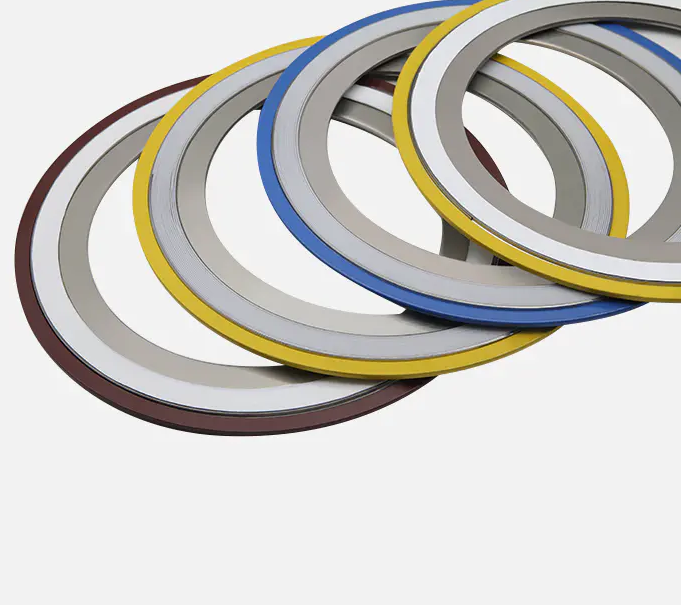RILSON GASKET
Ningbo Rilson Sealing Material Co., Ltd is dedicated to ensuring the secure and dependable operation of fluid sealing systems, offering clients the appropriate sealing technology solutions.
Content
Selection is the first step in ensuring reliable gasket performance. Making the wrong choice can negate subsequent efforts.
Material mismatch between the media and operating conditions: The metal band (such as 304 or 316 stainless steel) and non-metallic filler band (such as graphite or PTFE) in the gasket must be able to withstand the media's corrosive properties, temperature, and operating pressure. If the material is not corrosion-resistant, or if graphite fails in oxidizing media, the gasket may corrode or erode. For example, incorrectly selecting ordinary stainless steel in highly corrosive media can rapidly damage the gasket.
Type mismatch between gasket and flange surface: Different flange sealing surface types (such as raised, concave-convex, and tongue-and-groove) require corresponding spiral wound gasket types. For example, a spiral wound gasket with an inner ring (or inner and outer rings) is generally recommended for raised face flanges (RF). The inner ring helps prevent excessive compression and inward buckling (unwinding) of the gasket under high pressure and facilitates alignment. Misselecting a basic gasket can easily lead to failure.
Incorrect Size Selection: The gasket size should ensure uniform compression. A gasket that is too wide may result in insufficient compression; a gasket that is too narrow may collapse due to excessive compression. The inner ring size should also ensure smooth flow to avoid throttling and erosion.


Bolt Preload Issues:
Uneven: Failure to tighten the bolts in diagonal steps will result in uneven force on the gasket, leading to localized leakage.
Insufficient: Insufficient preload prevents the initial seal from forming, and the media pressure will directly push the gasket apart.
Excessive: Excessive preload may crush non-metallic packing, damage the metal band, and cause the gasket to lose its resilience, making it unable to compensate for fluctuating operating conditions.
Flange Surface Condition:
Uneven or Non-Parallel: Non-parallel flange surfaces or insufficient flange rigidity (deformation during bolt tightening) can prevent the gasket from fitting evenly.
Surface Damage or Residue: Radial scratches, pits, corrosion marks, or residual gasket fragments and dirt on the sealing surface can impair the gasket's effective seal.
Improper installation methods:
such as failure to clean flange surfaces, failure to use lubricant (resulting in inaccurate bolt torque values and uneven preload), or failure to use a calibrated torque wrench.
Severe Fluctuations in Pressure and Temperature: Frequent temperature and pressure cycling is a common cause of gasket failure. This can cause bolt stress to relax and preload to decrease. Although spiral wound gaskets have excellent resilience, failure can occur if fluctuations exceed their ability to compensate or if the gasket stress relaxes. Special care should be taken during system startups, shutdowns, or process changes.
Media Erosion and Corrosion: High-velocity media or media containing solid particles can erode and abrade the gasket surface, especially when soft filler materials like graphite are washed away, leading to leaks. Corrosive media can corrode both metallic and non-metallic strips.
System Vibration and Water Hammer: Continuous vibration from equipment such as pumps and compressors can gradually loosen bolts and reduce preload. Water hammer (or pressure surge) generates significant transient stress, which can directly cause gasket unwinding or damage.
Accurate Selection: Carefully consider the media characteristics (corrosiveness, presence of particles), temperature and pressure parameters (especially the fluctuation range), and flange sealing surface configuration. Select the correct gasket material, type, and size according to the standards. Never substitute a low-quality gasket for a high-quality gasket.
Proper Installation:
Clean the flange surface: Ensure it is free of dirt, residue, and damage.
Inspect the gasket: Verify that it is intact and of the correct type and size.
Proper Tightening: Use a calibrated torque wrench to tighten the bolts in diagonal steps (at least three steps) to ensure uniform preload. Be sure to lubricate the bolt threads and the bearing surface of the nut to ensure that the applied torque is effectively converted into bolt preload.
Control Operating Conditions: Operate smoothly, avoiding sudden changes in temperature and pressure as much as possible, and minimizing severe fluctuations and shock.
Regular inspection and maintenance: When the system is shut down for maintenance, check whether the bolt pre-tightening force is loose (heat tighten if necessary), check the condition of the flange sealing surface, and replace the gasket in time to avoid reusing the old gasket.